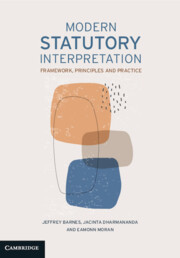Refine search
Actions for selected content:
36807 results in Cambridge Textbooks
28 - The principle of legality
- from Part VII - The wider context
-
- Book:
- Modern Statutory Interpretation
- Published online:
- 05 January 2023
- Print publication:
- 10 January 2023, pp 432-449
-
- Chapter
- Export citation
Part VI - Interpretation Acts and other Acts of general application
-
- Book:
- Modern Statutory Interpretation
- Published online:
- 05 January 2023
- Print publication:
- 10 January 2023, pp 375-418
-
- Chapter
- Export citation
10 - Legislative drafting
- from Part III - Working with legislation: Broader skills and knowledge
-
- Book:
- Modern Statutory Interpretation
- Published online:
- 05 January 2023
- Print publication:
- 10 January 2023, pp 149-162
-
- Chapter
- Export citation
1 - Social class
- from Part 1 - Reassessing the pillars of sociology
-
- Book:
- Making Sense of Mass Education
- Published online:
- 28 February 2023
- Print publication:
- 10 January 2023, pp 10-29
-
- Chapter
- Export citation
11 - Enactment procedure
- from Part III - Working with legislation: Broader skills and knowledge
-
- Book:
- Modern Statutory Interpretation
- Published online:
- 05 January 2023
- Print publication:
- 10 January 2023, pp 163-180
-
- Chapter
- Export citation
6 - Text-based interpretation
- from Part II - The framework of statutory interpretation
-
- Book:
- Modern Statutory Interpretation
- Published online:
- 05 January 2023
- Print publication:
- 10 January 2023, pp 72-82
-
- Chapter
- Export citation
3 - Constitutional context
- from Part I - Background
-
- Book:
- Modern Statutory Interpretation
- Published online:
- 05 January 2023
- Print publication:
- 10 January 2023, pp 36-46
-
- Chapter
- Export citation
Index
-
- Book:
- Parker and Evans's Inside Lawyers' Ethics
- Published online:
- 05 January 2023
- Print publication:
- 10 January 2023, pp 363-370
-
- Chapter
- Export citation
4 - Sexualities
- from Part 1 - Reassessing the pillars of sociology
-
- Book:
- Making Sense of Mass Education
- Published online:
- 28 February 2023
- Print publication:
- 10 January 2023, pp 81-100
-
- Chapter
- Export citation
6 - Ethical challenges in civil dispute resolution
-
- Book:
- Parker and Evans's Inside Lawyers' Ethics
- Published online:
- 05 January 2023
- Print publication:
- 10 January 2023, pp 168-209
-
- Chapter
- Export citation
5 - Governance
- from Part 2 - The foundations of an alternative approach
-
- Book:
- Making Sense of Mass Education
- Published online:
- 28 February 2023
- Print publication:
- 10 January 2023, pp 104-121
-
- Chapter
- Export citation
Abbreviations
-
- Book:
- Parker and Evans's Inside Lawyers' Ethics
- Published online:
- 05 January 2023
- Print publication:
- 10 January 2023, pp xiii-xiv
-
- Chapter
- Export citation
5 - Ethics in criminal justice
-
- Book:
- Parker and Evans's Inside Lawyers' Ethics
- Published online:
- 05 January 2023
- Print publication:
- 10 January 2023, pp 137-167
-
- Chapter
- Export citation
Part III - Working with legislation: Broader skills and knowledge
-
- Book:
- Modern Statutory Interpretation
- Published online:
- 05 January 2023
- Print publication:
- 10 January 2023, pp 147-218
-
- Chapter
- Export citation

Modern Statutory Interpretation
- Framework, Principles and Practice
-
- Published online:
- 05 January 2023
- Print publication:
- 10 January 2023
-
- Textbook
- Export citation

Parker and Evans's Inside Lawyers' Ethics
-
- Published online:
- 05 January 2023
- Print publication:
- 10 January 2023
-
- Textbook
- Export citation
Index
-
- Book:
- Introduction to Parallel Programming
- Published online:
- 27 October 2022
- Print publication:
- 05 January 2023, pp 277-282
-
- Chapter
- Export citation
Chapter Five - Percolation on ℤ𝑑
-
- Book:
- Network Models for Data Science
- Published online:
- 22 March 2023
- Print publication:
- 05 January 2023, pp 105-135
-
- Chapter
- Export citation
Glossary
-
- Book:
- The Psychology of Poverty, Wealth, and Economic Inequality
- Published online:
- 13 December 2022
- Print publication:
- 05 January 2023, pp 317-327
-
- Chapter
- Export citation
Chapter 1 - An Introduction to the Reproductive Biology of Flowering Plants
-
- Book:
- Reproductive Biology of Angiosperms
- Published online:
- 05 January 2024
- Print publication:
- 05 January 2023, pp 1-8
-
- Chapter
- Export citation
